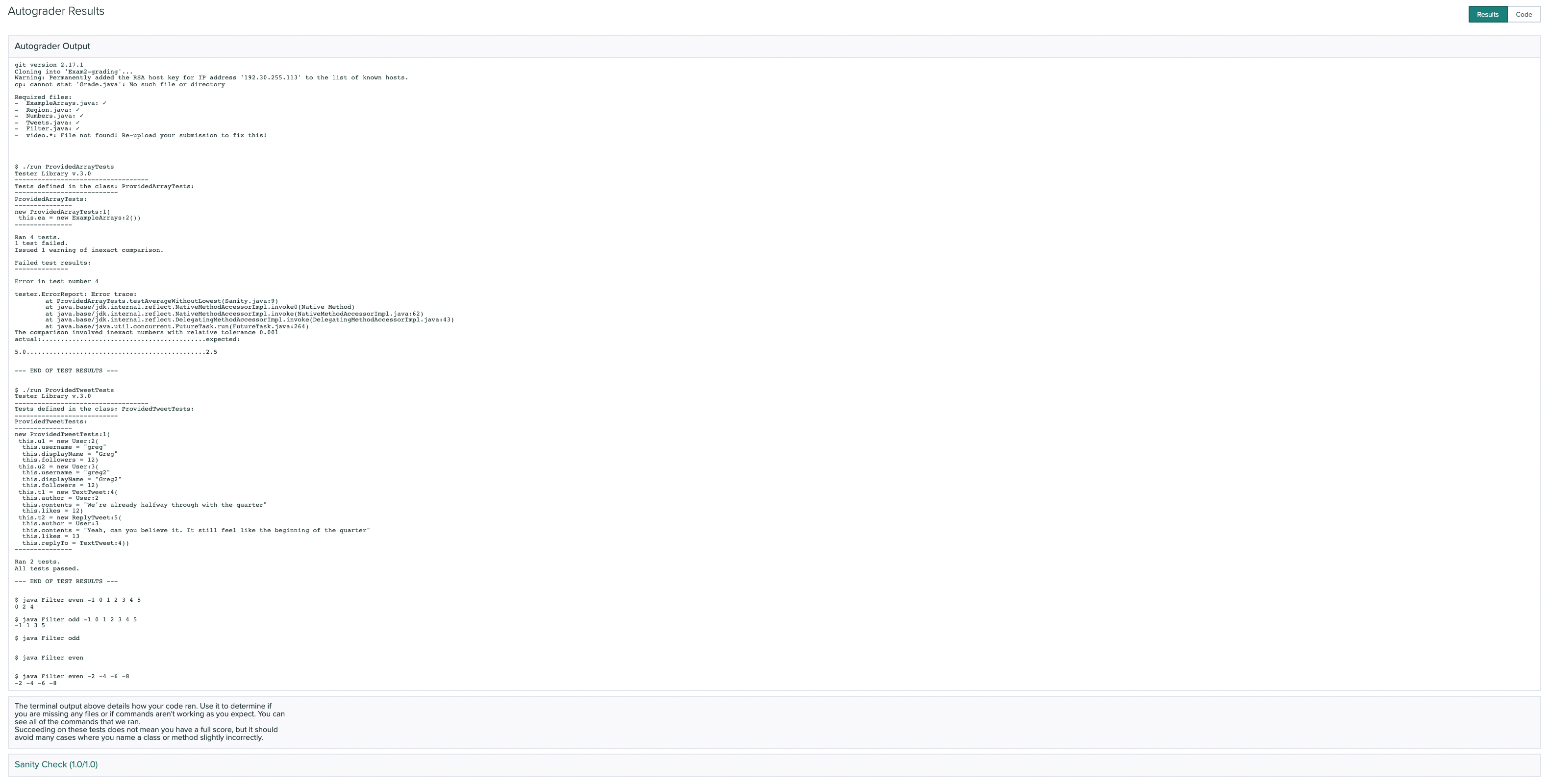Final Exam
Release: 8am Tuesday March 15, 2022
Due: 8am Friday March 18, 2022
This page details a take-home exam that you will complete over the next few days. You can’t communicate with anyone about the content of the assignment until you receive your grade. You can message us privately on Piazza, but the course staff will not give programming advice or answer most questions, including clarifications, about the problems. If you have technical trouble creating a screencast (detailed below) feel free to reach out for assistance.
Do not use any online service other than Piazza to ask questions about the assignment. Do not search for, solicit, or use solutions to the problems that you find elsewhere for the exam. These are all violations of academic integrity that students have committed on exams like this in the past.
You can make use of any course notes, online resources about Java and its libraries, Java tools, and so on to complete the exam, including re-using code from class notes.
You can review the grading policy for exams in the syllabus. You will complete the programming task below and submit your work to the appropriate Gradescope assignment for each part of the exam.
Starter code is available here:
https://github.com/ucsd-cse11-w22/cse11-finalexam-starter
The starter code will contain 3 folders, each of which will be labeled and will contain starter code corresponding to that portion of the Final Exam.
The starter code has been marked with the following annotation:
// Task #.#: [Title]
// Your code here
You will only need to add code where you see this annotation.
Make sure to look at your Gradescope submission after submitting to see if all the required files are there.
All coding tasks will be autograded.
Make sure that your submission passes autograder for your code to be properly graded.
If you are having issues with getting the autograder to run successfully, you may find it helpful to consult the Developing with the Gradescope Autograder in Mind guide.
If your submission passes the autograder, then you should see output similar to:

Be aware that the Sanity check does not check for code correctness, but rather that your code compiles.
Your submission will be graded after the deadline. You should test thoroughly yourself to make sure your program works as expected.
Clarifications
Can I use a Java feature/library/method that we haven’t covered in class?
Yes, just make sure it doesn’t break the autograder. The course staff is not responsible for fixing any submissions that fail the autograder during or after the exam.
Can we write more methods than specified?
Yes, you can write additional helper methods.
Can I use previous code that I wrote for a PA in my exam?
Yes.
Final Exam - Part 1
This part of the final corresponds to Exam 1 material. A set of incomplete tests will be provided in Sanity.java.
You will submit the following files to the Final Exam - Part 1 Gradescope assignment:
Interest.javaBank.javavideo.*
Task 1 – Interest Calculation
In the Interest class in Interest.java, you will use the design recipe to write two methods:
-
simpleInterest, which takes three doubles representing the principal amount, rate of interest(%) and time period (in years) and returns the simple interest(double). Round off the result to 2 decimal places. -
compoundInterest, which takes four doubles representing the principal amount, rate of interest(%), time period (in years), n(months/yr) and returns the compound interest(double). Round off the result to 2 decimal places. Recall that the interests are given by

Note that it’s fine to add more methods than what we’ve listed, but these two methods must appear as described.
Note that you should use the full design recipe – include enough examples to convince yourself the method works
Task 2 – Bank Account Modelling
You will complete the following tasks in Bank.java.
In Bank.java, you will add:
- A new class called Customer that represents a particular customer of the bank.
- The customer must have an
intfield calledidrepresenting the Customer’s id, aStringfield callednamerepresenting the Customer’s name, andStringfield called phone representing the Customer’s phone number. - A constructor for Customer that takes arguments
id,name, andphonein that order.
In the class Account, you will add:
- A new field of type
Customerin Account that represents theCustomerholding the account. - Add
Customeras the last parameter of the Account constructor. - A new method in
Accountnameddepositthat takes adoubleas an argument and updates the balance in the account by adding the deposit amount. Return a string stating “Deposit successful”. Do not inlude the double quotes in your answer. - A new method in
Accountnamedwithdrawthat takes adoubleas an argument and updates the balance in the account by subtracting the deposit amount if there is sufficient balance. Return a string stating “Withdrawal successful”. In case there is no sufficient balance, return a string stating “Insufficient balance”. Do not update the balance in this case.
In the class Bank, you will add and save to a field:
- At least 1
Customerobject - At least 1
Accountobject - At least 1 example of the
depositmethod - At least 2 examples of the
withdrawmethod, where at both cases must be shown.
Note that If you do not name these fields exactly, you will fail the autograder.
Video Task
You will record a short video of no more than 5 minutes.
Tip: If you find yourself running out of time, you might be explaining your code too much. If the task does not ask you to directly explain your code, you don’t need to explain it.
Include:
-
Show only your face and a picture ID (your student ID is preferred but any picture ID with your name on it will work) for a few seconds at the beginning. You don’t have to be on camera the whole time, though it’s fine if you are. Just a brief confirmation that it’s you creating the video/doing the work attached to the work itself is what we want. If you do not have a webcam, take a picture of yourself (and your picture ID) with your phone and display that picture at the start of your screen share.
- Take an example for the compoundInterest method, and explain how the program works. Highlight all of the lines of code that evaluate when that example runs; mark those lines with a comment at the end of the line as you go.
- Highlight the 2 examples you wrote for withdraw method. Highlight all of the lines of code that evaluate when one of those examples runs.
- Be sure to verbally explain your steps as you complete the above task.
Final Exam - Part 2
This part of the final corresponds to Exam 2 material. A set of incomplete tests will be provided in Sanity.java.
You will submit the following files to the Final Exam - Part 2 Gradescope assignment:
Mode.javaPrime.javaToText.javavideo.*
Task 1 - Mode
In the class Mode in Mode.java, you will write a single method called mode that takes an int[] as argument and returns the int mode of the int[]. If there are ties about which the mode is, you may return either mode. If there are no elements in the int[], then you will return 0.
Mode is defined as the number that appears the most amount of times.
Task 2 - Prime Numbers
In the class Prime in Prime.java, you will write a main method that will read non-negative ints from the command line and will print (on a new line) each int that is prime. If there are no int passed to your program from the command line or if there are no prime integers, print nothing, not even a new line.
To assist you in this task, we have provided a helper method isNumPrime that will determine whether or not an int is prime.
Task 3 - ToText
In the file ToText.java, we have provided code for the Region interface and 4 classes that implement Region. You task will be to add a toText() method to the Region interface and implement it in all 4 classes.
- For RectRegion, return the string
Rectangle - For CircleRegion, return the string
Circle - For UnionRegion, return the string
Union(<region1>, <region2>) - For IntersectRegion, return the string
Intersect(<region1>, <region2>)
For both UnionRegion and IntersectRegion, <region> corresponds to the toText()representation of that corresponding region.
Note that you must match this exactly, meaning that the tester will be case sensitive and space sensitive.
Video Task
Create a video of no more than 5 minutes:
- Show your ID as usual
- Run an example of
modewhere the mode is not the first or last element in the array. Show the output, then write a loop table of a single loop in the body ofmodeshowing each variable’s value before and after each loop iteration. Put this table as a comment and follow the same format as described in the video task for Exam 2 - Be sure to verbally explain your steps as you complete the above task.
- There is no video task associated with Task 2 and Task 3
Final Exam - Part 3
This part of the final corresponds to Exam 3 material. A set of incomplete tests will be provided in Sanity.java.
You will submit the following files to the Final Exam - Part 3 Gradescope assignment:
Sum.javaOccurrence.javavideo.*
Task 1 - Sum
Consider the following interface:
interface Summable<T> {
int getVal(T t);
}
In the class Sum, you will write a non-static generic method called sum which will take as its first argument a generic List and a generic Summable object. It will return a single int representing the sum of all the elements in the list.
If there are no elements in the list or if any of the arguments are null, return 0.
Task 2 - Occurrence
In the class Occurrence in Occurrence.java, you will write a program that will take text file names as command line arguments and print out the word that occured the most times across all text files along with the number of times the word occured. You should print out each pair of values in the form word, occurrences. If there are ties, then print all the ties (in any order). If no text file names are given or all text files are empty, then print nothing, not even a new line.
Video Task
Create a video of no more than 5 minutes:
- Show your Face and ID as usual
- For
sum, write a new example whereListandSummableuse some custom type that you define and there are at least 3 elements in theList. Draw a stack trace of all the active method calls as your program sums up the second element in theList. Note, this means that thegetValmethod will be in the process of executing. Follow the same format as described in the video task for Exam 3 - Be sure to verbally explain your steps as you complete the above task.
- There is no video task associated with Task 2
 Schedule
Schedule Calendar
Calendar Syllabus
Syllabus Questions
Questions Material
Material Assignments
Assignments Help Hours
Help Hours